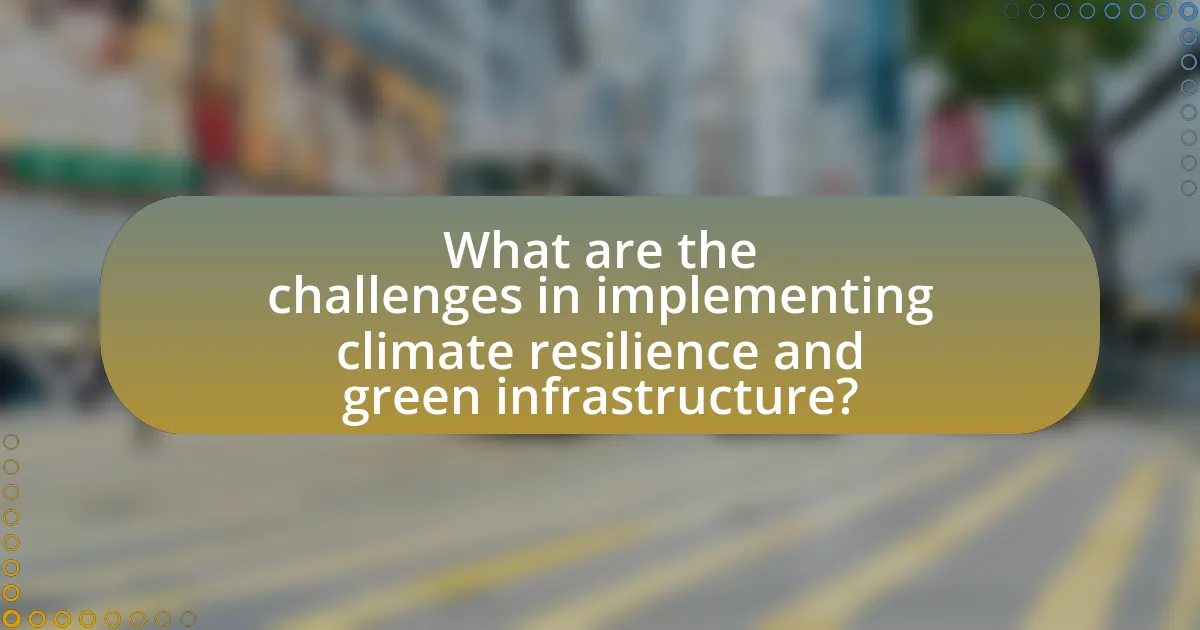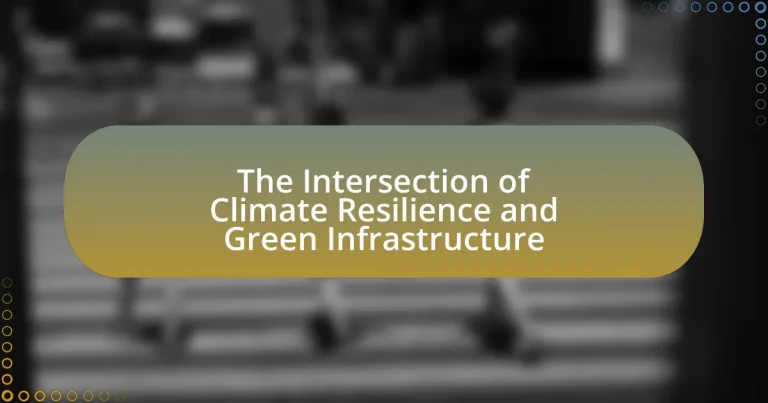The main entity of the article is the intersection of climate resilience and green infrastructure, which highlights their combined role in enhancing urban adaptability to climate change impacts. The article outlines how climate resilience enables communities to prepare for and recover from adverse climate events, while green infrastructure, including natural systems like parks and green roofs, provides essential ecosystem services. Key principles of climate resilience, the benefits of integrating green infrastructure, and the challenges faced in implementation are discussed, along with strategies for overcoming these barriers. The article emphasizes the importance of community engagement, policy support, and collaborative approaches in fostering effective climate resilience and sustainable urban environments.

What is the Intersection of Climate Resilience and Green Infrastructure?
The intersection of climate resilience and green infrastructure lies in their combined ability to enhance urban environments’ adaptability to climate change impacts. Climate resilience refers to the capacity of communities to anticipate, prepare for, respond to, and recover from adverse climate events, while green infrastructure encompasses natural and semi-natural systems that provide ecosystem services, such as stormwater management and urban cooling. Research indicates that integrating green infrastructure, such as green roofs and permeable pavements, can significantly reduce urban heat effects and manage flooding, thereby improving a city’s resilience to climate-related challenges. For instance, a study by the National Oceanic and Atmospheric Administration (NOAA) highlights that cities employing green infrastructure can lower surface temperatures by up to 5 degrees Fahrenheit, demonstrating a direct link between these strategies and enhanced climate resilience.
How do climate resilience and green infrastructure relate to each other?
Climate resilience and green infrastructure are interconnected as green infrastructure enhances a community’s ability to withstand climate impacts. Green infrastructure, which includes natural systems like parks, green roofs, and wetlands, mitigates flooding, reduces urban heat, and improves air quality, thereby directly contributing to climate resilience. For instance, a study by the National Oceanic and Atmospheric Administration (NOAA) highlights that urban areas with increased green spaces can lower surface temperatures by up to 5 degrees Fahrenheit, demonstrating how such infrastructure can reduce heat-related vulnerabilities. Thus, the integration of green infrastructure is essential for building climate resilience in urban planning and development.
What are the key principles of climate resilience?
The key principles of climate resilience include adaptability, sustainability, and integration. Adaptability refers to the ability of systems to adjust to changing climate conditions, ensuring they can withstand and recover from climate-related shocks. Sustainability emphasizes the importance of maintaining ecological balance and resource availability for future generations. Integration involves incorporating climate resilience strategies into broader planning and development processes, ensuring that infrastructure, policies, and community practices work together to enhance resilience. These principles are supported by frameworks such as the IPCC’s guidelines, which highlight the necessity of adaptive capacity and sustainable practices in mitigating climate impacts.
What defines green infrastructure in urban planning?
Green infrastructure in urban planning is defined as a strategically planned network of natural and semi-natural areas that provide environmental, social, and economic benefits. This approach integrates green spaces, such as parks, green roofs, and wetlands, into urban settings to manage stormwater, improve air quality, and enhance biodiversity. Research indicates that cities employing green infrastructure can reduce urban heat effects by up to 5 degrees Celsius and manage up to 90% of stormwater runoff, demonstrating its effectiveness in promoting climate resilience and sustainability.
Why is the intersection of these concepts important?
The intersection of climate resilience and green infrastructure is important because it enhances urban adaptability to climate change while promoting environmental sustainability. This synergy allows cities to mitigate the impacts of extreme weather events, such as flooding and heatwaves, by utilizing natural systems like parks and green roofs to absorb rainwater and reduce urban heat. Studies show that cities implementing green infrastructure can reduce stormwater runoff by up to 65%, significantly decreasing flood risks and improving water quality. Therefore, integrating these concepts not only fosters ecological health but also strengthens community resilience against climate-related challenges.
How does this intersection address environmental challenges?
The intersection of climate resilience and green infrastructure addresses environmental challenges by integrating natural systems into urban planning to enhance ecosystem services and mitigate climate impacts. This approach reduces urban heat, improves air quality, and manages stormwater effectively, thereby decreasing flooding risks. For instance, cities that implement green roofs and permeable pavements can lower surface temperatures by up to 5 degrees Fahrenheit and reduce runoff by 60%, as evidenced by studies conducted by the U.S. Environmental Protection Agency. These strategies not only bolster community resilience against climate change but also promote biodiversity and improve overall urban livability.
What role does community engagement play in this intersection?
Community engagement plays a crucial role in the intersection of climate resilience and green infrastructure by fostering collaboration between stakeholders, enhancing local knowledge, and ensuring that solutions are tailored to community needs. Engaged communities contribute valuable insights about local environmental conditions and social dynamics, which can inform the design and implementation of green infrastructure projects. For instance, studies have shown that community involvement in urban planning leads to more effective and sustainable outcomes, as seen in the case of the Green Streets Initiative in Seattle, where local input significantly improved project relevance and acceptance. This collaborative approach not only builds trust but also empowers communities to take ownership of climate resilience efforts, ultimately leading to more adaptive and sustainable urban environments.

What are the benefits of integrating climate resilience with green infrastructure?
Integrating climate resilience with green infrastructure enhances urban sustainability and reduces vulnerability to climate impacts. This integration allows cities to manage stormwater effectively, mitigate urban heat, and improve air quality through natural systems. For instance, green roofs and permeable pavements can absorb rainwater, reducing flooding risks and promoting groundwater recharge. Additionally, urban forests can lower temperatures by providing shade, which is crucial in combating heatwaves. Studies show that cities implementing green infrastructure can see a reduction in stormwater runoff by up to 65%, demonstrating its effectiveness in climate resilience strategies.
How does this integration enhance urban sustainability?
This integration enhances urban sustainability by promoting the use of green infrastructure to improve climate resilience in cities. Green infrastructure, such as green roofs, permeable pavements, and urban forests, helps manage stormwater, reduce urban heat, and improve air quality. For instance, a study by the National Oceanic and Atmospheric Administration found that urban areas with increased green space can reduce surface temperatures by up to 5 degrees Fahrenheit, mitigating the urban heat island effect. Additionally, green infrastructure can absorb up to 90% of rainfall, significantly decreasing flooding risks and enhancing water quality. These benefits collectively contribute to more sustainable urban environments by fostering ecological balance and improving the quality of life for residents.
What specific environmental benefits arise from this integration?
The integration of climate resilience and green infrastructure provides specific environmental benefits such as enhanced biodiversity, improved air quality, and effective stormwater management. Enhanced biodiversity occurs as green infrastructure creates habitats for various species, promoting ecological balance. Improved air quality results from vegetation that absorbs pollutants and carbon dioxide, contributing to healthier urban environments. Effective stormwater management is achieved through permeable surfaces and green roofs that reduce runoff and mitigate flooding, thereby protecting water quality. These benefits collectively support sustainable urban development and climate adaptation strategies.
How does it improve public health and well-being?
Green infrastructure improves public health and well-being by enhancing air quality, reducing urban heat, and promoting physical activity. For instance, trees and vegetation filter pollutants, leading to lower rates of respiratory diseases; studies show that urban areas with more greenery experience a 30% reduction in asthma-related hospital visits. Additionally, green spaces encourage outdoor activities, which contribute to physical fitness and mental health, as evidenced by research indicating that access to parks can increase exercise levels by 25%. Furthermore, green infrastructure mitigates flooding and heatwaves, reducing stress on healthcare systems and improving community resilience.
What economic advantages does this integration provide?
The integration of climate resilience and green infrastructure provides significant economic advantages, including cost savings in disaster recovery and reduced infrastructure maintenance expenses. For instance, green infrastructure such as urban forests and permeable pavements can mitigate flooding, leading to lower costs associated with stormwater management and disaster response. A study by the National Oceanic and Atmospheric Administration (NOAA) found that investing in green infrastructure can yield a return of $2 to $4 for every dollar spent by reducing flood damage and improving water quality. Additionally, this integration can enhance property values and attract businesses, as communities with robust green infrastructure are often more desirable places to live and work.
How can green infrastructure reduce costs for municipalities?
Green infrastructure can reduce costs for municipalities by minimizing the need for expensive gray infrastructure and reducing stormwater management expenses. For instance, implementing green roofs, permeable pavements, and urban forests can lower the costs associated with flooding and water treatment. A study by the American Society of Civil Engineers found that green infrastructure can save municipalities up to 30% in stormwater management costs by reducing runoff and improving water quality. Additionally, green infrastructure enhances property values and can lead to increased tax revenues, further offsetting municipal expenses.
What are the long-term financial benefits for communities?
Long-term financial benefits for communities include increased property values, reduced infrastructure costs, and enhanced economic resilience. Communities that invest in green infrastructure, such as parks and sustainable drainage systems, often see property values rise by 5% to 20% due to improved aesthetics and environmental quality. Additionally, green infrastructure can lower stormwater management costs by up to 50%, as it reduces the need for expensive gray infrastructure. Furthermore, these investments can lead to job creation in sectors related to environmental management and maintenance, contributing to a more robust local economy. Studies indicate that every $1 invested in green infrastructure can yield $3 in economic benefits, demonstrating the financial viability of such initiatives.

What are the challenges in implementing climate resilience and green infrastructure?
The challenges in implementing climate resilience and green infrastructure include funding limitations, regulatory hurdles, and community engagement issues. Funding limitations often arise due to the high initial costs associated with green infrastructure projects, which can deter investment despite long-term savings and benefits. Regulatory hurdles can complicate project approval processes, as existing policies may not adequately support innovative approaches to climate resilience. Additionally, engaging communities in the planning and implementation phases is crucial, yet often difficult, as differing priorities and lack of awareness can lead to resistance or apathy towards proposed initiatives. These challenges are documented in various studies, including the National Oceanic and Atmospheric Administration’s report on climate adaptation strategies, which highlights the importance of addressing financial, regulatory, and social barriers to effectively implement climate resilience measures.
What barriers do cities face in adopting these practices?
Cities face several barriers in adopting climate resilience and green infrastructure practices, primarily including financial constraints, regulatory challenges, and lack of public awareness. Financial constraints often stem from limited budgets and competing priorities, making it difficult for cities to allocate sufficient resources for green initiatives. Regulatory challenges arise from outdated zoning laws and building codes that may not support innovative green practices. Additionally, a lack of public awareness and engagement can hinder community support for these initiatives, which is crucial for successful implementation. According to a report by the American Society of Civil Engineers, cities that invest in green infrastructure can see long-term cost savings, but initial investment remains a significant hurdle.
How do funding and resource allocation impact implementation?
Funding and resource allocation significantly impact the implementation of climate resilience and green infrastructure projects by determining the availability of necessary financial and material resources. Adequate funding enables the development of comprehensive plans, hiring skilled personnel, and acquiring technology essential for effective implementation. For instance, a study by the National Oceanic and Atmospheric Administration (NOAA) found that cities with dedicated funding for green infrastructure projects were able to reduce urban flooding by up to 30%, demonstrating the direct correlation between financial investment and successful project outcomes. Furthermore, resource allocation influences prioritization, ensuring that critical areas receive attention and that projects align with community needs and environmental goals.
What are the political challenges associated with these initiatives?
Political challenges associated with initiatives in climate resilience and green infrastructure include conflicting interests among stakeholders, regulatory hurdles, and funding limitations. Stakeholders such as local governments, businesses, and community groups often have differing priorities, which can lead to disagreements on project implementation. Regulatory hurdles arise from complex permitting processes and compliance with existing environmental laws, which can delay or obstruct initiatives. Additionally, funding limitations are a significant barrier, as securing financial resources for green infrastructure projects often competes with other budgetary needs, making it difficult to prioritize climate resilience initiatives. These challenges are evident in various case studies, such as the difficulties faced by cities in implementing green roofs due to zoning laws and funding constraints.
How can these challenges be overcome?
To overcome challenges at the intersection of climate resilience and green infrastructure, implementing integrated planning and policy frameworks is essential. These frameworks should promote collaboration among stakeholders, including government agencies, private sectors, and communities, to ensure that green infrastructure projects are designed to address specific climate risks. For instance, cities like New York have successfully utilized green roofs and permeable pavements to manage stormwater and reduce urban heat, demonstrating the effectiveness of such integrated approaches. Additionally, investing in research and development of innovative green technologies can enhance the adaptability and efficiency of infrastructure, as evidenced by studies showing that urban green spaces can reduce flooding by up to 30%.
What strategies can be employed to secure funding?
To secure funding for projects at the intersection of climate resilience and green infrastructure, organizations can employ strategies such as developing comprehensive project proposals, leveraging partnerships, and utilizing grant opportunities. Comprehensive project proposals should clearly outline objectives, expected outcomes, and the potential impact on climate resilience, which can attract funders interested in sustainability. Partnerships with local governments, NGOs, and private sector entities can enhance credibility and broaden funding sources, as collaborative efforts often demonstrate a greater potential for success. Additionally, organizations can explore various grant opportunities from government agencies, foundations, and international bodies that prioritize climate-related initiatives, as evidenced by the increasing availability of funding through programs like the Green Climate Fund, which has committed billions to support climate resilience projects globally.
How can stakeholder collaboration enhance implementation?
Stakeholder collaboration enhances implementation by fostering shared goals and pooling resources, which leads to more effective decision-making and project execution. When diverse stakeholders, including government agencies, community organizations, and private sector partners, work together, they can leverage their unique expertise and perspectives to address complex challenges in climate resilience and green infrastructure. For instance, a study by the National Oceanic and Atmospheric Administration (NOAA) found that collaborative approaches in coastal management resulted in improved project outcomes and increased community engagement. This collaborative synergy not only accelerates the implementation process but also ensures that the solutions developed are more sustainable and widely accepted by the community.
What are best practices for fostering the intersection of climate resilience and green infrastructure?
Best practices for fostering the intersection of climate resilience and green infrastructure include integrating nature-based solutions into urban planning, promoting community engagement in green projects, and implementing policies that support sustainable land use. Nature-based solutions, such as green roofs and urban forests, enhance biodiversity and reduce urban heat, contributing to climate resilience. Community engagement ensures that local knowledge and needs are incorporated, leading to more effective and accepted green infrastructure initiatives. Policies that incentivize green infrastructure investments can drive funding and support for projects that mitigate climate impacts, as evidenced by cities like New York and San Francisco, which have successfully integrated these practices into their climate action plans.
How can cities effectively plan and design green infrastructure projects?
Cities can effectively plan and design green infrastructure projects by integrating ecological principles into urban planning, engaging stakeholders, and utilizing data-driven approaches. This involves assessing local environmental conditions, identifying areas for green space, and prioritizing projects that enhance biodiversity and resilience to climate change. For instance, cities like New York have implemented the Green Infrastructure Plan, which focuses on stormwater management through green roofs and permeable pavements, resulting in a 40% reduction in runoff in targeted areas. Additionally, involving community members in the planning process ensures that projects meet local needs and foster public support, as seen in the case of the Los Angeles River revitalization project, which included extensive community input. By leveraging these strategies, cities can create sustainable and effective green infrastructure that addresses both environmental and social challenges.
What role does policy play in supporting these initiatives?
Policy plays a crucial role in supporting climate resilience and green infrastructure initiatives by providing a framework for funding, regulation, and implementation. Effective policies can allocate resources for sustainable projects, incentivize private investment, and establish standards that promote environmentally friendly practices. For instance, the U.S. Green Building Council’s LEED certification program is supported by policies that encourage energy-efficient building practices, demonstrating how regulatory frameworks can drive the adoption of green infrastructure. Additionally, policies that integrate climate adaptation strategies into urban planning ensure that communities are better prepared for climate impacts, thereby reinforcing the importance of policy in fostering resilience.


